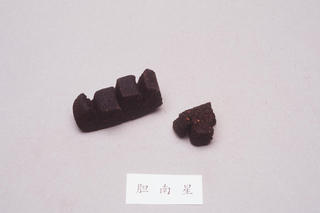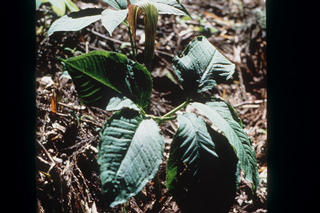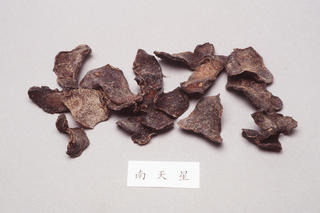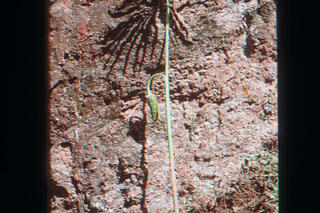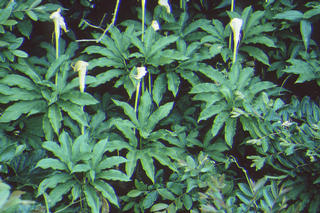Arisaema erubescens
Contents
Nomenclature
Other Names:
Historical Use of Arisaema erubescens
Arisaema erubescens in Traditional Chinese Medicine
Background
Chinese Name (pinyin): Dannanxing
Chinese Name :
Common Name :Bile Arisaema
Specific Name : Arisaema Cum Bile
Scientific Name:
Collection :
Description : Cubic or cylindrical, brownish-yellow, greyish-brown or brownish-black. Texture: hard, odor: slightly fishy, taste: bitter.
Identification : (1) Powder: Pale yellowish-brown, parenchymatous cells subrounded filled with gelatinized starch granules. Raphides of calcium oxalate 20-90µm long. Spiral and annular vessels 8-60µm in diameter.(2). 0.2g of the powder, add 5ml of water, shake and filter. Transfer 2ml of the filtrate to a test tube furfural (1?100) and add 2ml of sulfuric acid along the tube wall, brownish-red ring is produced at the junction of the two layers.
Processing :
Action : To remove heat and resolve phlegm, and to calm the nerves.
Indication : cough with yelloish sticky expectoraion; stroke, mania, epilepsy
Precautions :
Dosage : 3 to 6 g.
Storage : Preserve in a ventilated dry place, protected from moth.
Nomenclature
Other Names:
Historical Use of Arisaema erubescens
Arisaema erubescens in Traditional Chinese Medicine
Background
Shengnanxing ÉúÄÏÐÇ
Zhinanxing ÖÆÄÏÐÇ
Chinese Name (pinyin): Tiannanxing
Chinese Name :
Common Name :Arisaema Tuber
Specific Name : Rhizoma arisaematis
Scientific Name:
Collection : The drug is collected in autumn and winter when the stem and leaf are withered, removed from fibrous root and outer tissue and dried.
Description : Oblate, 1 - 2 cm high, 1.5 - 6.5 cm in diameter, Externally whitish or brownish, relatively smooth. Top with dented stem scars, encircled with numerous pitted fibrous root scar, some tuber surrounded by small oblate lateral buds. Texture hard uneasily broken, fracture uneven, white and starchy, odour acrid, taste numb and pungent.
Identification : Powder: Whitish, starch granules mainly simple, spherical oblong, 2 - 17 µm in diameter, hilum pointed, slit shaped, faint striation of large granules visible. Compound granules few, consisting of 2 - 12 components. Needle crystals of calcium oxalate scattered or in bundles embedded in mucilage cells. 63 - 131 µm long. Prisms of calcium oxalate mostly found in parenchymatous cells accompanied by vessels, 3 - 20 µm in diameter.
Processing : Rhizoma Arisaematis (unprepared) Eliminate foreign matter, wash clean and dry.(Prepared): Take clean Rhizoma Arisaematis, grade according to size, soak in water separately and change water 2 - 3 times a day, add alumen after changing water if white foam is produced (to each 100 kg of Rhizoma Arisaematis add 2 kg of Alumen). After soaking for a day, change water again and take out when the cut surface of the drug has a taste of slight tongue-numbing sensation. Boil the slices of Rhizoma Zingeberis and Alumen in a pot with a quatity of water then add Rhizoma Arisaematis and boil until the cut surface of the drug is absent from the dry center part. Take out and removed Rhizoma Zingiberis, dry the drug in air briefly, cut into thin slices and dry thoroughly. To each 100 kg of Rhizoma Arisaematis add 12.5 kg of Rhizoma Zingiberis and 12.5 kg of Alumen.
Action :
Indication : intractable phlegm with cough; vertigo; stroke with phlegm in the throat, deviation of the eye and the mouth, hemiplegia; epilepsy and convulsions; tetanus. External use for boils, sores, snake and insect bites
Precautions :
Dosage : 3-10g
Storage :
Synonymns for Arisaema erubescens
Patent Medicines and Medicines with Multiple Ingredients that include Arisaema erubescens
Pharmaceutical Information
Chemical Constituents
Evidence or the Use of Arisaema erubescens in the Treatment of Epilepesy
Basic Science
Animal Studies
Cohort, Case-Control and Non-Randomized Trials
Randomized Controlled Trials
Meta-Analysis
1st Five Results: pubmed search
Luo Zeng, Wei-Jie Shu, Hua He, Tao Li, Xiao-Chen Yang, Li Li
##Title##
Ecol Evol: 2023, 13(11);e10696
[PubMed:37928192]
[WorldCat.org]
[DOI]
(P e)
Jin Wang, Xiaoyong Ding, Chang-An Guo, Xiong Zhang, Haowen Feng, Huizhao Yang, Yuhua Wang
An ethnobotanical study of wild edible plants used by the Tibetan in the Rongjia River Valley, Tibet, China.
J Ethnobiol Ethnomed: 2023, 19(1);49
[PubMed:37891585]
[WorldCat.org]
[DOI]
(I e)
Min Wang, Na Yang, Xu Wu, Ting Zou, Jiahui Zheng, Huaijun Zhu, Chongbo Zhao, Jing Wang
##Title##
Drug Des Devel Ther: 2023, 17;1831-1846
[PubMed:37360574]
[WorldCat.org]
[DOI]
(I e)
Tianyi Zhang, Fusheng Xu, Markus Ruhsam, Li Feng, Miao Zhang, Zhengwei Wang, Xumei Wang
A nucleotide signature for the identification of Pinelliae Rhizoma (Banxia) and its products.
Mol Biol Rep: 2022, 49(8);7753-7763
[PubMed:35670929]
[WorldCat.org]
[DOI]
(I p)
Na Sun, Jia-Yi Liu, Wan-Ying Yu, Su-Su Liu, Yu-Long Ren, Kai-Xing Fang, Peng-Hua Shu
[Research progress on chemical constituents and biological activities of Arisaematis Rhizoma].
Zhongguo Zhong Yao Za Zhi: 2021, 46(20);5194-5200
[PubMed:34738419]
[WorldCat.org]
[DOI]
(P p)
